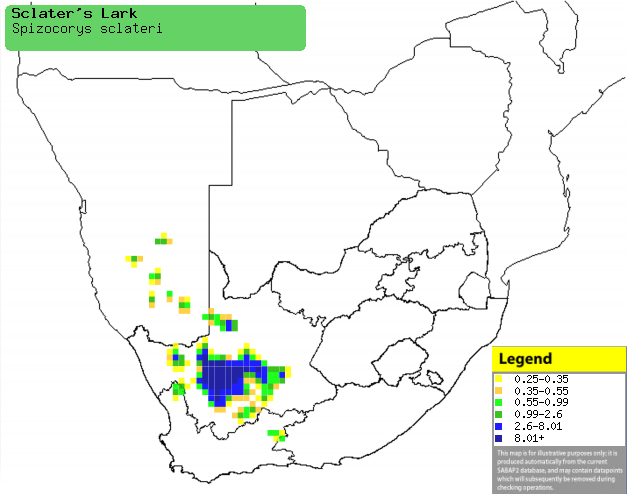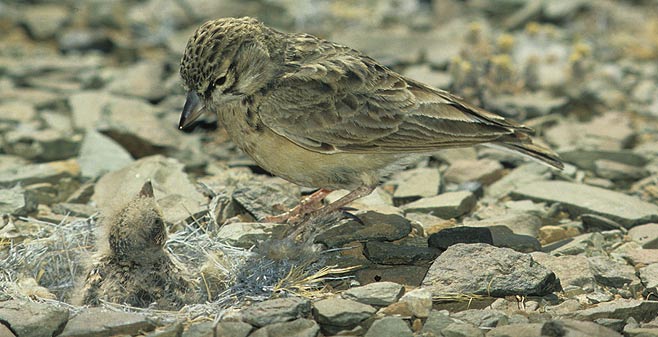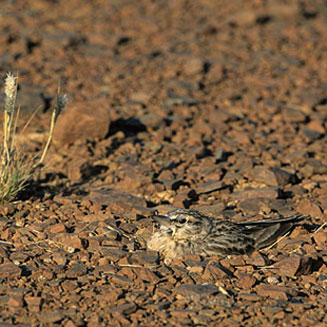|
Spizocorys sclateri (Sclater's
lark)
Namakwalewerik [Afrikaans]; Namagua-leeuwerik [Dutch];
Alouette de Sclater [French]; Sclaters kurzhaubenlerche [German]; Cotovia
de Scatler [Portuguese]
Life
> Eukaryotes >
Opisthokonta
> Metazoa (animals) >
Bilateria >
Deuterostomia > Chordata >
Craniata > Vertebrata (vertebrates) > Gnathostomata (jawed
vertebrates) > Teleostomi (teleost fish) > Osteichthyes (bony fish) > Class:
Sarcopterygii (lobe-finned
fish) > Stegocephalia (terrestrial
vertebrates) > Tetrapoda
(four-legged vertebrates) > Reptiliomorpha > Amniota >
Reptilia (reptiles) >
Romeriida > Diapsida > Archosauromorpha > Archosauria >
Dinosauria
(dinosaurs) > Saurischia > Theropoda (bipedal predatory dinosaurs) >
Coelurosauria > Maniraptora > Aves
(birds) >
Order: Passeriformes > Family: Alaudidae
> Genus: Spizocorys
Distribution and habitat
Endemic to southern Africa, occurring from southern Namibia
to the Northern Cape, marginally extending into the Western Cape. It generally
prefers stony (especially with quartz gravel) arid or semi-arid open plains with
sparsely scattered shrubs and grass tufts.
|
 |
|
Distribution of Sclater's lark in southern Africa,
based on statistical smoothing of the records from first SA Bird Atlas
Project (©
Animal Demography unit, University of
Cape Town; smoothing by Birgit Erni and Francesca Little). Colours range
from dark blue (most common) through to yellow (least common).
See here for the latest distribution
from the SABAP2. |
Food
It mainly eats seeds supplemented with insects, doing its
foraging on the ground, plucking seeds from dead grass tufts and exposing food
items beneath pebbles. The following food items have been recorded
in its diet:
- Insects
- Seeds
- grass
- Enneapogon desvauxii (Kalkgras)
- Brachiara (signal grasses)
- Schmidtia kalahariensis (Kalarisandkweek)
- shrubs
- forbs
Breeding
- The nest (see images below) is a neat cup built of dry grass leaves and
stems, thickly lined with shredded grass. It is typically placed in an
excavated hollow at ground level, surrounded by a rim of shale gravel or
quartz pebbles and usually with few if any shrubs or grass tufts in the
vicinity. Nesting in the open leaves it vulnerable to both predation and the
midday sun, however the thick lining may insulate the eggs from high surface
temperatures and it is also difficult to spot the nest from afar.
 |
|
Sclater's lark with chick in nest. [photo Peter
Steyn ©] |
 |
|
|
Sclater's lark at its nest, Maltahöhe, Namibia.
[photo Warwick
Tarboton ©] |
|
- Egg-laying season is from April-November, peaking from August-November.
- It lays a single egg, which is incubated by both sexes for about 13
days. During particularly hot days, incubation shifts are only 11-65 minutes
each, so that each adult can leave to cool off.
- The chicks are brooded constantly by both parents in the midday to keep
them cool, leaving the nest after about 10-14 days, before they can fly
(soon taking shelter from the heat beneath a shrub). It is possible that the
cause of it consistently laying only one egg may be because it is necessary
for both adults to brood the chicks in the heat of the day, making it
difficult for them to feed more than one chick. However, there are other
species of lark that manage to raise 2 nestlings in much more extreme
conditions (such as the Black-crowned sparrowlark in Saudi Arabia).
Threats
Near-threatened because of its localised
distribution and low breeding success, also it is not particularly common in
protected areas. In one study, its overall breeding success was found to be only
20%, based on data from 46 nests. Most of the eggs and chicks lost were eaten by
predators, although nestlings were occasionally drowned by thunderstorms.
References
-
Hockey PAR, Dean WRJ and Ryan PG 2005. Roberts
- Birds of southern Africa, VIIth ed. The Trustees of the John Voelcker
Bird Book Fund, Cape Town.
|
